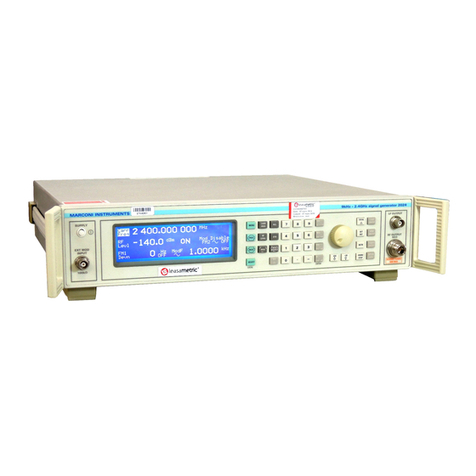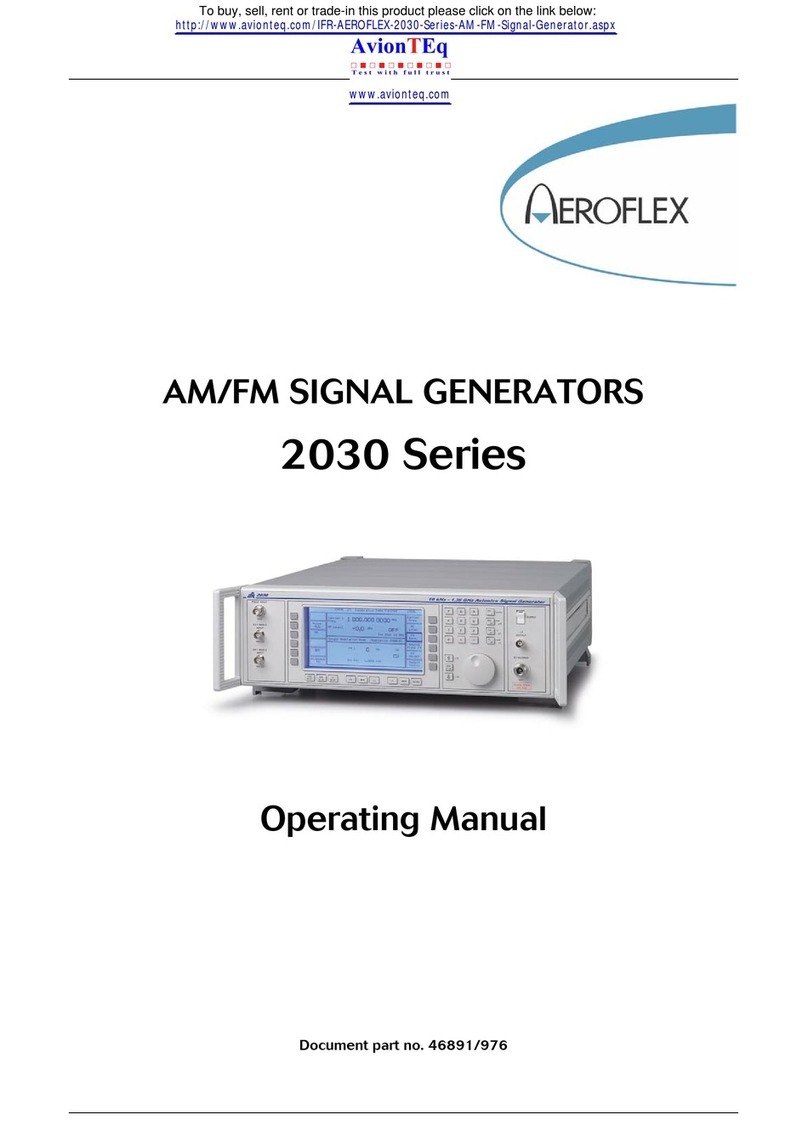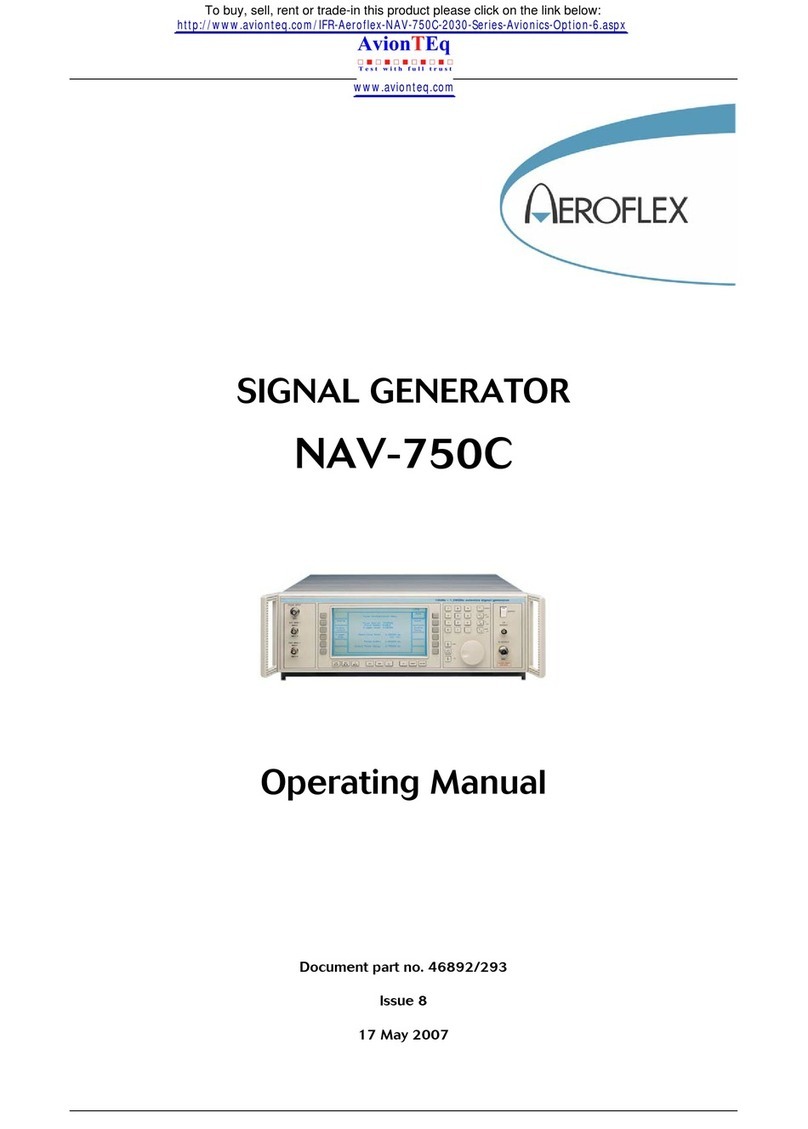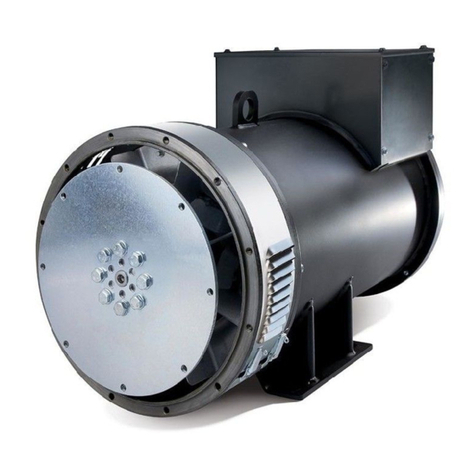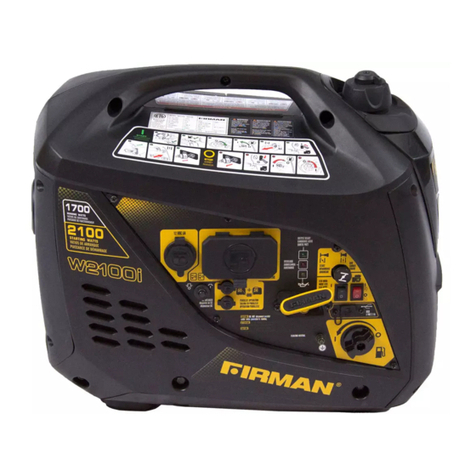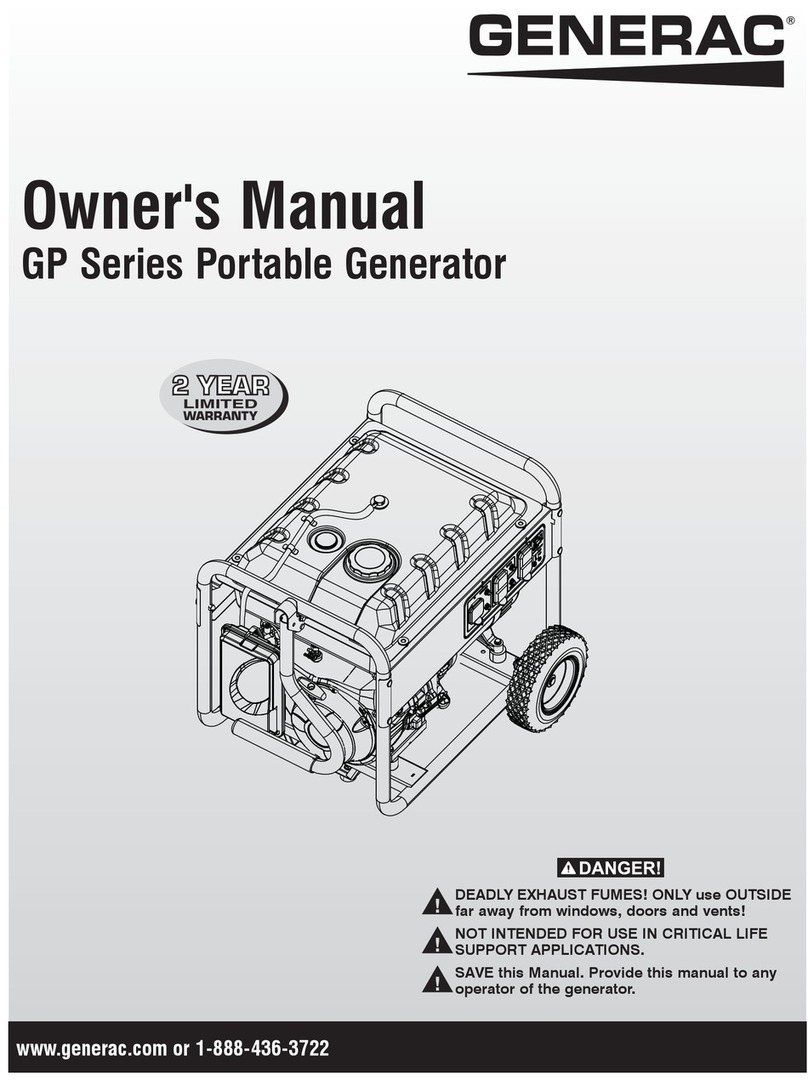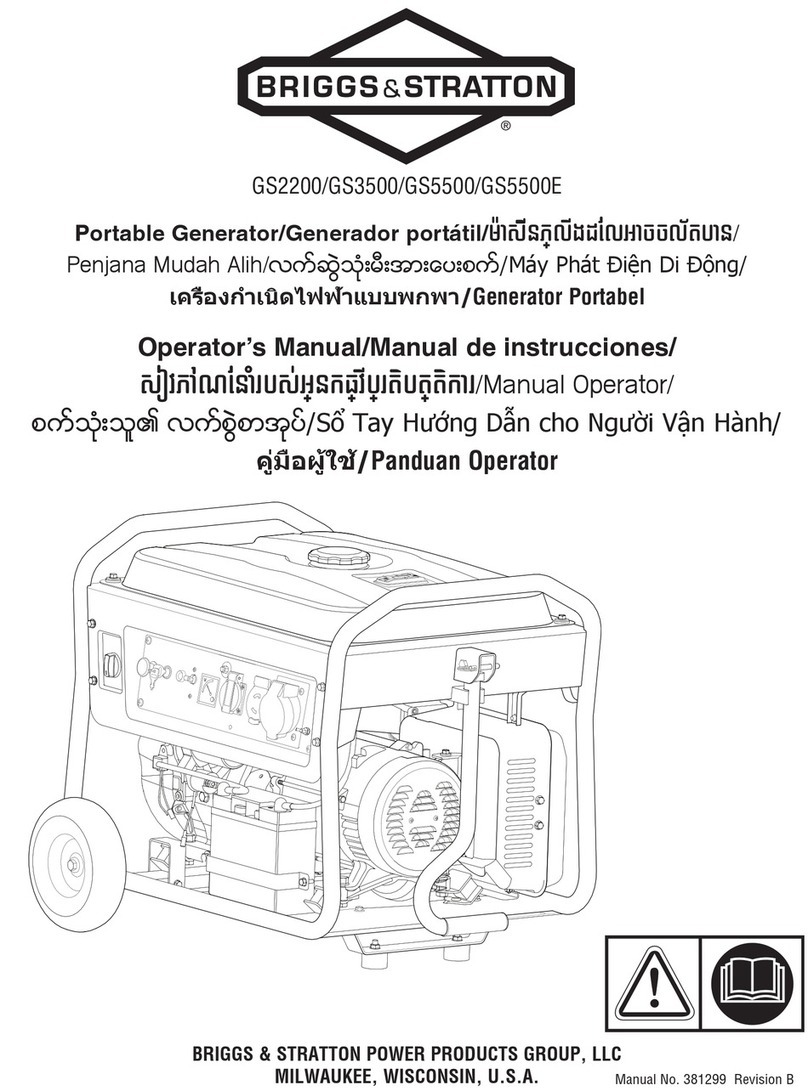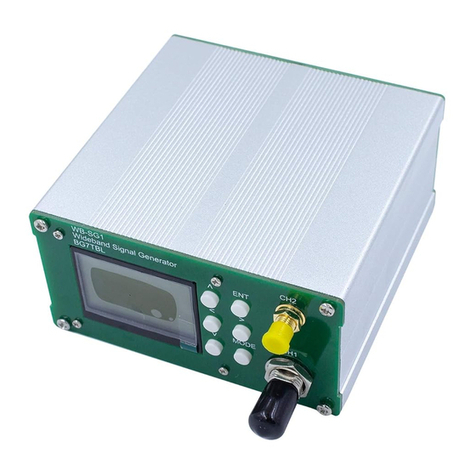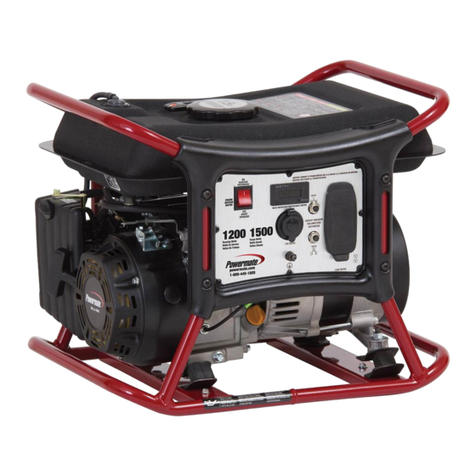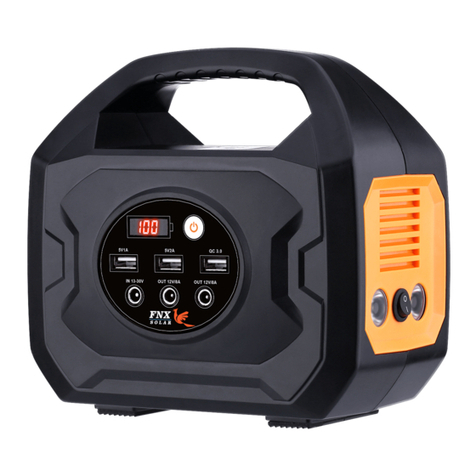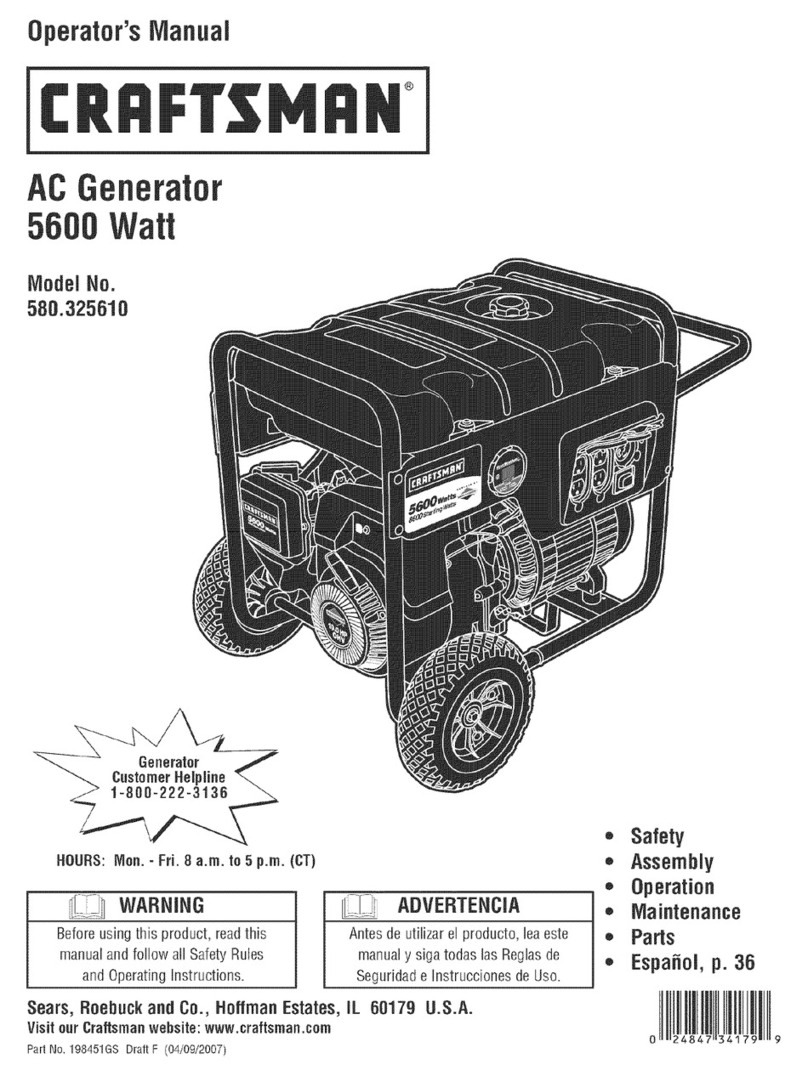Aeroflex 3410 Series User manual

For the very latest specifications visit www.aeroflex.com
AAnn aaggiillee ssiiggnnaall ggeenneerraattoorr tthhaatt ccoommbbiinneess wwiiddee ffrreeqquueennccyy ccoovveerr aanndd hhiigghh ppeerrffoorrmmaannccee vveeccttoorr
mmoodduullaattiioonn iinn aa ssmmaallll ppaacckkaaggee,, mmaakkiinngg iitt iiddeeaall ffoorr tteessttiinngg wwiirreelleessss ccoommmmuunniiccaattiioonn ssyysstteemmss aanndd
ccoommppoonneennttss
Signal Sources
3410 Series Digital RF Signal Generators
• Wide frequency coverage
250 k z to 2 G z (3412)
250 k z to 3 G z (3413)
250 k z to 4 G z (3414)
• Fast RF frequency and level settling for
high speed testing
• igh performance vector modulation for
improved component test
• Optional dual channel arbitrary waveform
generator (ARB)
• Low adjacent channel power for receiver
selectivity and amplifier linearity testing
• Fast GPIB response to maximize ATE sys-
tem performance
•12345 RF waveform creation soft-
ware
• Wide bandwidth FM and AM modulation
capability
• Optional Differential I/Q outputs for sim-
plified component test interfacing
• Optional high speed pulse modulation
capability
• Compact and lightweight package
• Simple to use touch panel interface
• RF optimization modes - Low Noise, Low
ACP and igher Power
The 3410 series are portable, lightweight signal generators covering
a wide range of carrier frequencies to 4 GHz. High quality analog
and vector modulation capabilities make these signal generators
ideal for research, development and manufacturing applications.
Careful attention to the design of the modulators and the RF system
ensures that these signal generators exhibit low levels of adjacent
channel power, making them suitable for the most demanding
amplifier linearity and receiver selectivity measurements.
The use of IFR fractional N synthesis techniques, combined with
fast level control and an electronic attenuator, ensures the 3410
series signal generators are both frequency and level agile for high
speed ATE testing.
peration
A flexible but intuitive user interface based on a touch panel display
system ensures that the signal generator meets the needs of
unskilled as well as skilled operators. The instrument can be con-
figured to the required mode of operation very simply, with numeri-
cal data being entered by the keyboard or via a rotary control. The
display shows the primary parameters in a clear and unambiguous
format, minimizing the risk of operator error.
RF utput
The 3410 series signal generators provide peak output power of up
to +16 dBm. With a level resolution of 0.01 dB, repeatable and accu-
rate testing of wireless components can be performed.

The electronic attenuator is ideal for high volume applications where
attenuator life is critical. A user defined RF level limit can be entered
to ensure that the signal generator cannot provide damaging signal
levels when testing less robust components. Careful attention to the
level control system guarantees that positive level transients cannot be
generated. The fast responding electronic reverse power protection
system helps ensure long life and high reliability when testing high
power systems.
Spectral Purity
Receiver measurements require good spectral purity from a signal
generator. The 3410 series have excellent performance with typically
4.5 Hz residual FM at 1 GHz and a floor noise of typically better than
-148 dBc / Hz.
Modulation
Comprehensive modulation facilities are provided for supporting the
testing of analog or digital RF systems. A single key press turns the
modulation on and off, providing a fast method for signal to noise
checking.
Modulation Modes
Vector Modulation
The built-in IQ modulator provides state-of-the-art vector modulat-
ed signals with excellent level linearity, low vector error and low noise.
With a typical vector bandwidth up to 50 MHz, the modulator is able
to support wideband as well as narrow-band wireless standards.
Internal calibration systems ensure the modulator performance can
be quickly optimized to reduce vector errors and ensure low carrier
leak at all operating frequencies.
The linearity of the modulator and the RF output system is reflected
in the excellent adjacent channel power when generating multi-carri-
er non-constant envelope signals such as cellular CDMA and
TETRA.
Typical 3GPP 2 carrier test model 1 (64 channels)
Analog Modulation
With typical AM bandwidth to 30 MHz and typical FM bandwidth to
20 MHz, the 3410 series signal generators are ideal tools for testing
broadcast systems. The wide bandwidths allow video signals to mod-
ulate the carrier with minimal distortion.
The wideband FM facilities allow the generation of fast-swept sig-
nals, while the use of an IFR-patented DC FM system ensures that
carrier frequency errors when the FM are DC coupled is minimal.
The specifications for AM are maintained to high carrier frequencies
to support the use in modern EMC testing applications. The signal
generator maintains excellent phase noise performance even when
generating wideband modulated signals.
Modulation scillator
An internal modulation oscillator is provided which can be used to
generate two tones in the frequency range 0.1 Hz to 50 kHz. In addi-
tion to sine waves, the modulation oscillator can provide square waves,
triangular and sawtooth waveforms for narrow band sweeping.
Digital Modulation
A dual channel arbitrary (ARB) waveform generator is available as an
option. Fitted internally this allows the user to select from a library of
pre-stored IQ modulator drive waveforms to provide accurately mod-
ulated carriers simulating the characteristics of digitally modulated
communication systems.
Using a patented technique, the dual channel ARB is able to take
waveform files typically four times oversampled and run them
through a real time interpolation system to raise the sampling rate of
the file. This ensures the generation of low adjacent channel power
and low spectral noise density. The dual channel ARB is suited for
the generation of both narrow band and wideband signals, including
WCDMA signals, without the use of switched reconstruction filters.
Combining a large ARB memory with the smaller file size required to
define a waveform allows the ARB to store up to 180 waveforms.
Alternatively the whole of the memory can be devoted to a single file.
One such file would store over 1.5 seconds of a 3GPP WCDMA wave-
form signal. The use of interpolation techniques ensures that when
narrow band systems are simulated the waveform generator can still
operate at a high sample rate without requiring excessively large

For the very latest specifications visit www.aeroflex.com
amounts of data to be loaded or restricting the repetition time. The
library waveforms are structured in a directory form to ease their
selection and the optimization of the user’s generator. The modula-
tion waveforms can be simply changed by selection from a file list
with the changeover between waveforms occurring in a few millisec-
onds rather than the many seconds required in more traditional wave-
form generators.
The file name can be determined by the user to convey a useful
description of the contents of the file.
The 3410 series are all supplied with a free copy of 12345, a
software package to aid the creation and download of files to the ARB.
12345is a Windowsbased software utility that enables a user
to set up a modulation scheme and then create an ARB file using
modulation templates. The resulting file may be saved on a PC or
downloaded into the ARB. User-defined configurations can also be
saved. Consequently, it is possible to load previously saved setups to
regenerate the ARB files quickly and easily. The capabilities of
12345include:-
Generic Modulation Types:
PSK, FSK, MSK, QAM modulation types
Nyquist, Root Nyquist and Gaussian filters
PRBS, fixed pattern and user defined data sources
IQ errors - residual carrier, IQ imbalance, quadrature offset
Also included are 2G, 2.5G and 3G cellular TDMA and CDMA digi-
tal standards along with WLAN and other cordless phone standards.
In addition, 12345includes a utility that allows user-defined
waveforms, created using software simulation tools such as MAT-
LAB, to be converted and packaged into a form that can be down-
loaded into the 3410 Series ARB.
12345is continually updated to include new modulation capa-
bilities and facilities; The latest version is available for download at
www.aeroflex.com
I/Q utputs
Single ended baseband I/Q outputs are available as standard.
Differential I/Q outputs, combined with comprehensive voltage bias
and offset facilities, are optionally available to simplify component and
module testing.
Pulse Modulator
An optional pulse modulator allows the generation of fast rise time RF
signals with on/off ratios that meet the most demanding radar and
ECM/ECCM test applications.
Remote Control
The 3410 series include a fast GPIB system ensuring minimum
elapsed time to receive instructions over the bus. Combined with the
agile RF hardware this ensures fast and effective operation in ATE
applications. Frequency switching speed is typically less than 4 ms
and level switching is typically accomplished in under 5 ms. The pro-
tocol and syntax of the GPIB commands have been designed in
accordance with IEEE 488.2 to simplify program generation. Plug
and play drivers are available that include a soft front panel for remote
instrument supervision and debug.
Frequency Standard
The 3410 series include a high stability OCXO as standard. The
inclusion of a main input power standby mode maintains the oscilla-
tor at working temperature while the rest of the instrument is pow-
ered down. Time to full specification working is thereby minimized
for equipment facilities held on standby.
Size
The 2U rack height ensures the 3410 series occupy minimal space in
a manufacturing rack or on the engineer's bench, allowing the provi-
sion of more compact test systems. The full rack width ensures easy
stacking of instruments while the light weight allows for easy carry-
ing in the laboratory or the field.
SSPPEECCIIFFIICCAATTIINN
CCAARRRRIIEERR FFRREEQQUUEENNCCYY
Range
250 kHz - 2 GHz (3412)
250 kHz - 3 GHz (3413)
250 kHz - 4 GHz (3414)
Resolution
1 Hz, accuracy as frequency standard
The carrier output phase can be advanced or retarded in increments of
0.036°.
RRFF UUTTPPUUTT
The RF output is controlled by an ALC system in normal operation.
When IQ modulation is enabled alternative control modes are available
to optimize the performance of the signal generator.
Range
Electronic Attenuator
≤
10 MHz -140 to +13 dBm
≤
2 GHz -140 to +16 dBm
≤
3 GHz -140 to +16 dBm
≤
3.75 GHz -140 to +13 dBm
≤
4 GHz -140 to +10 dBm
Mechanical Attenuator
≤
10 MHz -140 to +16 dBm
≤
2 GHz -140 to +19 dBm
≤
3 GHz -140 to +16 dBm
No Attenuator
≤
10 MHz 0 to +21 dBm
≤
2 GHz 0 to +22 dBm
≤
3 GHz 0 to +22 dBm
≤
3.75 GHz 0 to +20 dBm
≤
4 GHz 0 to +17 dBm
When AM is selected the maximum RF output is linearly reduced by up
to 6 dB depending on the requested AM depth.
Resolution
0.01 dB
RF level units
Units can be set to µV, mV, V EMF or PD; dB relative 1 µV, 1 mV, 1 V
EMF or PD; or dBm. Conversion between dB and linear units may be
achieved by pressing the appropriate units key (dB or V, mV or µV).

RF Output Accuracy (@ 23°C ± 5°C)
Electronic Attenuator
RF Mode -127 to -24 dBm >-24 dBm
Power
≤
2 GHz ±0.75 dB ±0.50 dB
≤
3 GHz ±1.00 dB ±0.75 dB
-110 to -24 dBm >-24 dBm
≤
4 GHz ±1.25 dB ±1.00 dB
-127 to -30 dBm >-30 dBm
Noise
≤
2 GHz ±0.75 dB ± 0.50 dB
≤
3 GHz ±1.00 dB ±0.75 dB
-110 to -30 dBm >-30 dBm
≤
4 GHz ±1.25 dB ±1.00 dB
-127 to -40 dBm >-40 dBm
ACP
≤
2 GHz ±0.75 dB ±0.50 dB
≤
3 GHz ±1.00 dB ±0.75 dB
-110 to -40 dBm >-40 dBm
≤
4 GHz ±1.25 dB ±1.00 dB
Mechanical Attenuator
RF Mode -127 to -22 dBm >-22 dBm
Power
≤
2 GHz ±0.75 dB ± 0.50 dB
≤
3 GHz ±1.00 dB ±0.75 dB
-127 to -28 dBm >-28 dBm
Noise
≤
2 GHz ±0.75 dB ± 0.50 dB
≤
3 GHz ±1.00 dB ±0.75 dB
-127 to -38 dBm >-38 dBm
ACP
≤
2 GHz ±0.75 dB ±0.50 dB
≤
3 GHz ±1.00 dB ±0.75 dB
No Attenuator
RF Mode >0 dBm
Power
≤
2 GHz ±0.50 dB
Noise
≤
3 GHz ±0.75 dB
ACP
≤
4 GHz ±1.00 dB
Level Accuracy with IQ Modulation
For constant envelope modulation systems: typical standard level error
±0.15 dB
For non-constant envelope modulation systems: typical standard level
error ±0.25 dB
Temperature Stability
±0.02 dB/°C
RF Flatness
Typical flatness at 0 dBm
Output VSWR
Electronic attenuator
For output levels <0 dBm Frequency Output VSWR
≤2 GHz 1.25:1
≤3 GHz 1.40:1
≤4 GHz 1.50:1
For output levels >0 dBm VSWR is <1.5:1, ≤4 GHz
Mechanical Attenuator
For output levels <0 dBm Frequency Output VSWR
≤3 GHz 1.33:1
For output levels >0 dBm VSWR is <1.5:1, ≤4 GHz
No attenuator
<1.5:1 VSWR
Attenuator Repeatability
Mechanical attenuator typically 0.1 dB
Output Connector
Front panel 50
Ω
type N female to MIL-PRF-3901
Output Protection
Protects the instrument from externally applied RF power
(from a 50
Ω
source) of 50 W up to 3 GHz and 25 W up to 4 GHz.
The RPP trip may be reset from the front panel or via the remote inter-
face. For safety, the protection is also provided when the instrument is
switched off.
SSPPEECCTTRRAALL PPUURRIITTYY
All parameters stated at RF level
≤
+7 dBm in Noise and ACP RF
modes
Harmonics
<-30 dBc, typically <-40 dBc.
Sub and Non-Harmonics
For offsets >10 kHz
<-60 dBc for carrier frequencies ≤375 MHz
<-70 dBc for carrier frequencies ≤3 GHz
<-60 dBc for carrier frequencies ≤4 GHz
Residual FM (FM on CW)
<4.5 Hz RMS at 1 GHz in a 300 Hz to 3.4 kHz unweighted bandwidth
Typical esidual FM
SSB Phase Noise
For 20 kHz offset, Noise Optimized mode
CW IQ
≤375 MHz <-115 dBc/Hz <-115 dBc/Hz
500 MHz <-124 dBc/Hz <-124 dBc/Hz
1 GHz <-118 dBc/Hz <-118 dBc/Hz
2 GHz <-112 dBc/Hz <-112 dBc/Hz
3 GHz <-108 dBc/Hz <-108 dBc/Hz
4 GHz <-106 dBc/Hz <-106 dBc/Hz

For the very latest specifications visit www.aeroflex.com
Typical SSB Phase Noise at 1 GHz
Typical SSB Phase Noise Performance at 20 kHz Offset
Typical Phase Noise at 2.1 GHz
SSB AM Noise
SSB AM noise at 20 kHz offset (Typical values) measured at levels
>0 dBm
Frequency MHz CW/IQ (dBc/Hz)
≤
3 GHz -130
≤
4 GHz -125
Typical AM Noise at 1 GHz
RF Leakage
<0.5 µV PD at the carrier frequency into a single turn 25 mm loop
25 mm or more from the case of the signal generator, for carrier fre-
quencies <3 GHz.
Wideband Noise
Applicable for all carrier levels at offsets >5 MHz and <50 MHz
excluding thermal noise (23°C ±5°C)
RF Mode
≤
375 MHz
≤
3 GHz
Power <-138 dBc/Hz <-142 dBc/Hz (typ <-148 dBc/Hz)
Noise <-138 dBc/Hz <-142 dBc/Hz (typ <-148 dBc/Hz)
ACP <-135 dBc/Hz <-140 dBc/Hz
MMDDUULLAATTIINN
FM, AM and
Φ
M can be applied to the carrier using internal or exter-
nal modulation sources. The internal modulation source is capable of
generating two simultaneous signals into any one of the modulation
channels. The internal and external modulation sources can be simul-
taneously enabled in order to produce combined amplitude and fre-
quency (or phase) modulation.
Internal and external IQ modulation can be applied. In this mode, FM,
AM and
Φ
M are not permitted.
Optional Pulse modulation can be used in combination with FM, AM,
Φ
M and IQ from an external pulse source.
FREQUENCY MODULATION
Peak Deviation
Frequency Maximum Peak Deviation
250 kHz to 375 MHz 7.5 MHz
375 MHz to 750 MHz 3.75 MHz
750 MHz to 1.5 GHz 7.5 MHz
1.5 GHz to 3 GHz 15 MHz
3 GHz to 4 GHz 30 MHz
Displayed resolution is 4 digits or 1 Hz
FM Accuracy
At 1 kHz rate
±4% of set deviation excluding residual FM
FM Bandwidth
1 dB DC to 200 KHz (DC coupled, 100 k
Ω
)
10 Hz to 200 KHz (AC coupled, 100 k
Ω
)
3 dB DC to typically 20 MHz (DC or AC coupled, 50
Ω
)

Typical FM Bandwidth
Carrier Frequency Offset
For DC coupled FM ±(1 Hz + 0.1% of set deviation) after performing
a DCFM null operation
Total Harmonic Distortion
At 1 kHz rate
<0.2% for deviations up to 2% of maximum allowed deviation
<1% for deviations up to 20% of maximum allowed deviation
<3% at maximum deviation
PHASE MODULATION
Phase Deviation
0 to 10 radians
Displayed resolution is 4 digits or 0.01 radians
Accuracy
At 1 kHz rate
±4% of set deviation excluding residual phase modulation
Bandwidth
0.5 dB 100 Hz to 10 kHz (AC coupled, 100 k
Ω
)
Total Harmonic Distortion
At 1 kHz rate
<1% at 10 radians deviation
Typically <0.5% at 1 radian deviation
AMPLITUDE MODULATION
Specifications apply for carrier frequencies from 2 MHz up to 2 GHz,
usable to 4 GHz.
Modulation Depth
0 to 99.9%, Displayed resolution is 3 digits or 0.1%
Accuracy
At 1 kHz rate
±4% of set depth ±1% excluding residual AM
AM Bandwidth
1 dB DC to 200 kHz (DC coupled, 100 k
Ω
)
10 Hz to 200 kHz (AC coupled, 100 k
Ω
)
3 dB DC to typically 30 MHz (DC or AC coupled, 50
Ω
)
Typical AM Bandwidth
Total Harmonic Distortion
For 1 kHz modulation rate
<1% for depths ≤30%
<2% for depths ≤80%
FM on AM
Typically <20 Hz for 30% AM depth at a modulation rate of 1 kHz and
carrier frequency of 500 MHz
ΦΦ
M on AM
Typically <0.02 radian for 30% AM depth at a modulation rate of
1 kHz and carrier frequency of 500 MHz
IQ MODULATION
IQ Inputs
BNC connector inputs, selectable 50
Ω
/100 k
Ω
input impedance
Full scale input (I2+Q2)0.5 occurs for 0.5 V rms (The level requested is
obtained by applying 0.5 DC to either the I or Q input)
Typical IQ Bandwidth

For the very latest specifications visit www.aeroflex.com
Modulation Bandwidth Relative to DC
At 23°C ± 5°C:-
±0.5 dB for frequencies up to 5 MHz
3 dB:-
RF Mode ≤≤3 GHz ≤≤44GHz
Noise >35 MHz, 45 MHz typ >30 MHz, 40 MHz typ
ACP >40 MHz, 50 MHz typ >35 MHz, 45 MHz typ
DC Vector Accuracy
Relative to full scale (0.5 V RMS), RF level ≤≤+7 dBm:-
Static Error Vector Magnitude (EVM) <1% RMS at full scale
Magnitude error <0.5% RMS at full scale
Phase error <0.5° RMS at full scale
Residual Carrier Magnitude:-
For 0 V input voltage, relative to full scale
RF Mode
Noise <-45 dBc, typically <-50 dBc
ACP <-40 dBc, typically <-45 dBc
Valid for 12 hours after executing an IQ self-calibration and within
±5°C of the calibration temperature. The instrument displays a warn-
ing if the time or temperature limits are exceeded.
Static EVM and phase error measured with residual carrier magnitude
removed.
IQ Image Suppression
At 10 kHz modulation frequency
Typically <-50 dBc @ 10 kHz
Linearity
Adjacent Channel Performance (ACP) for continuous and discontinuous
signals at RF output levels
≤
0 dBm, over the temperature range 23°C
± 5°C:-
See chart below
RRFF BBUURRSSTT CCNNTTRRLL
A digital control bit is used to generate an analog ramp (up or down)
of the RF output. The Burst Gate control signal can either be generat-
ed internally as part of the optional internal base-band source, or pro-
vided externally by the user on the rear panel connector. When inter-
nally generated, the Burst Gate control signal appears on the rear
panel auxiliary connector that then serves as an output.
On/Off Ratio
For the temperature range 23°C ± 5°C
>80 dB for carriers
≤
3 GHz
>70 dB for carriers >3 GHz
Ramp Profile
Rise and fall time after the L-H and H-L transitions of the burst control
bit respectively, can be defined by the user from 10 µs to 999 µs in
0.1 µs steps.
Burst Gate control input is a TTL level (HCT), 50
Ω
impedance BNC
input on the rear panel.
RF ramp can be adjusted in time by ±50 µs in increments of
0.1 µs with respect to the trigger event.
RRFF BBUURRSSTT AATTTTEENNUUAATTIINN CCNNTTRRLL
A digital attenuation control bit (in conjunction with the ramp control
bit) is used to decrease the RF level from the set level to an alternative
level during burst modulation. The Burst Attenuation Trigger signal can
be provided internally as part of the optional dual arbitrary waveform
generator (ARB), or externally on a rear panel connector. When inter-
nally generated, the Burst Attenuation Trigger control signal appears on
the rear panel auxiliary connector that then serves as an output.
Attenuation range available is 0 to 70 dB.
Additional level error <0.5 dB.
Burst Attenuation Trigger control is a TTL level (HCT), 50
Ω
impedance
signal available on the rear panel Auxiliary connector.
RF burst attenuation requires Electronic Attenuator Opt 003.
TETRA GSM 900 / 1800 / 1900 GSM EDGE IS-95 (CDMAone)
(Enhanced Data rate
for GSM Evolution)
Frequency 130 MHz - 1 GHz 850 MHz - 1 GHz 850 MHz - 1 GHz 824 - 894 MHz
Range(s) 1700 - 1900 MHz 1700 - 1900 MHz 1850 - 2000 MHz
ACP <-70 dBc @ 25 kHz offset <-35 dBc @ 200 kHz offset <-35 dBc @ 200 kHz offset <-65 dBc @ 885 kHz offset
(Continuous & <-80 dBc* @ 50 kHz offset <-70 dBc @ 400 kHz offset <-70 dBc @ 400 kHz offset <-75 dBc @ 1.25 MHz offset
Discontinuous) <-80 dBc* @ 75 kHz offset <-80 dBc @ 600 kHz offset <-80 dBc @ 600 kHz offset <-80 dBc @ 1.98 MHz offset
3GPP/WCDMA NADC (IS - 54, IS - 136) JDC/PDC PHP/PHS
Frequency 1855 - 2200 MHz 824 - 894 MHz 810 - 826 MHz 1895 - 1918 MHz
Range(s) 1850 - 2000 MHz 940 - 956 MHz
1429 - 1513 MHz
ACP <-70 dBc @ 5 MHz offset <-40 dBc @ 30 kHz offset <-65 dBc @ 50 kHz offset <-75 dBc @ 600 kHz offset
(Continuous & <-72 dBc* @ 5 MHz offset <-78 dBc* @ 60 kHz offset <-80 dBc* @ 100 kHz offset <-80 dBc @ 900 kHz offset
Discontinuous) <-80 dBc* @ 90 kHz offset
* denotes typical value

IINNTTEERRNNAALL MMDDUULLAATTIINN SSCCIILLLLAATTRR
The internal modulation source is capable of generating up to two
simultaneous signals into any one of the modulation systems.
Frequency Range
0.1 Hz to 50 kHz with 0.1 Hz or 5 digits of resolution
Accuracy
As frequency standard
Distortion
<0.1 % for a sine wave at 1 kHz
In addition to a sine wave the following waveforms can be generated:
Triangle 0.1 Hz to 10 kHz
Ramp 0.1 Hz to 10 kHz
Square 0.1 Hz to 5 kHz
(Note: modulation frequency can be set to 50 kHz irrespective of
waveform type)
Level
Modulation source signals are available on the rear panel I/AM OUT
and Q/FM OUT at nominal level of 1 V peak EMF from 50
Ω
source
impedance.
EEXXTTEERRNNAALL MMDDUULLAATTIINN SSUURRCCEE
External inputs are available with a selectable input impedance of
50
Ω
or 100 k
Ω
(default setting), AC or DC coupled.
Apply 1 V RMS (default) or 1 V peak for the set modulation.
A HI/LO indicator when the applied signal is greater than ±6% from
nominal
External AM is input to EXT I/EXT AM front panel BNC connector.
External FM is input to EXT Q/EXT FM front panel BNC connector.
IINNTTEERRNNAALL DDUUAALL CCHHAANNNNEELL AARRBB SSUURRCCEE ((PPTTIINN 000055))
A high performance Dual Arbitrary (ARB) Waveform Generator that pro-
vides IQ signals for the IQ modulator
The ARB enables files to be downloaded with sample rates from
17 kHz to 66 MHz. The ARB uses an interpolation system to increase
the digital to analog converter sample rate and avoid the use of re-
construction filters.
Typical 3GPP test model 1 (64 channels)
ARB CHARACTERISTICS
Flash Memory Size
23,592,960 sample pairs
Maximum Number of Files
180
Sample Format
32 bits of data - 14 bits I, 14 bits Q, 3 associated marker bits
Sample Rate Tuning
± 20 ppm, 0.1 ppm step resolution
D-A Converter Resolution
14 bits
D-A Sample Rate
44 to 66 Msamples/s
Interpolation Factor
Automatically selected
Reconstruction Filter Stop Band Attenuation
>70 dB
ARB Spectral Purity
Spurious free dynamic range >70 dB, typically >80 dB
20 kHz offset phase noise <-120 dBc/Hz
Floor noise <-140 dBc/Hz
12345
™ Windows based software package is provided for the cre-
ation, formatting and downloading of ARB waveform files to the 3410
series.
A waveform library is provided on a CD containing a selection of files
for testing 2G, 2.5G and 3G systems. Files can be downloaded from
www.aeroflex.com.
Marker Control Bits
Up to 3 marker bits (1-3) can be attached to each sample of IQ data.
These can be used to indicate significant points in the waveform and
are available as outputs via the rear panel Aux IN/OUT connector.
Marker bit 1 can be used as RF Burst Control signal. Marker bit 2 can
be used as Burst Attenuation Trigger signal to decrease (attenuate)
the RF level from its nominal value.
Control Mode
Continuous, single or triggered operation of the ARB
An external trigger input signal is available on the AUX IN/OUT rear
panel connector.
IQ Outputs (Not applicable with Option 009 fitted)
The IQ signals produced by the ARB are available on the rear panel
I/AM OUT and Q/FM OUT BNC connectors. Output level is 0.5 V RMS
EMF (vector sum) from a source impedance of 50
Ω
.
DDIIFFFFEERREENNTTIIAALL II//QQ UUTTPPUUTT ((PPTTIINN 000099))
When differential I/Q outputs are enabled signal generator RF carrier
output is cw only.
Output Impedance
Can be used with single ended 50
Ω
loads or differential 100
Ω
loads.
Delivered bias voltages are halved with single ended loads
I/Q Bias Voltages
Independent I and Q channel bias voltages settable within the range of
±3 V

For the very latest specifications visit www.aeroflex.com
Bias voltage
Resolution 1.0 mV nominal
Accuracy ±2% ±4 mV max, ±1% ±2 mV typical
Offset See Bias Voltage above.
Differential offset voltage
Range ±300 mV
Resolution 100 µV nominal
Accuracy ±2% ±3.3 mV max, ±1% ±0.7 mV typical
Level mode
Variable IQ signal level over 45 dB range
Differential signal balance
typ 0.15 dB @10 MHz
I/Q channel balance
±0.2 dB @1 MHz
I/Q level imbalance adjust
±4 dB nominal continuously variable
I/Q signal amplitude
22.4 mV to 4 V pk-pk per channel
I/Q signal amplitude accuracy
<2% at 20 kHz, typ 1.5%, excludes termination errors
Baseband purity (2 V p-p set voltage at 1 MHz)
2nd Harm -70 dBc
3rd Harm -65 dBc
IMD -70 dBc (100 kHz tone spacing, at 1 MHz)
SSWWEEEEPP FFAACCIILLIITTYY
Provides a digital sweep of RF frequency or RF level in discrete steps
Start, stop, step size, number and step time can be controlled. Step
time may be set from 2.5 ms to 10 s with 0.1 ms resolution. (20 ms
for mechanical attenuator Option 002)
The sweep can be set to be continuous, single or externally triggered
from the rear panel.
Frequency Sweep
Linear step size: 1 Hz minimum step
Logarithmic: 0.01% to 50%, 0.01% step
Level Sweep
0.01 dB minimum step
FFAASSTT PPUULLSSEE MMDDUULLAATTRR ((PPTTIINN 000066))
This option requires Electronic Attenuator Option 003 to be fitted.
On/Off Ratio
>80 dB for carrier levels ≥-60 dBm
Rise/Fall Time
<20 ns typical (10 to 90%)
Pulse Delay
Typically <50 ns
RF Level Accuracy
RF mode = ‘auto’, as standard ±0.2 dB
The above specification is met for all power levels above 100 MHz. The
following restrictions apply below 100 MHz.
≤
0 dBm, for frequencies <10 MHz
≤
+10 dBm, for frequencies <100 MHz, but
≥
10 MHz
AM Depth and Distortion
AM depth and distortion specification is degraded for operation above
0 dBm at carrier frequencies <100 MHz
Video Breakthrough
RF Mode
Power <±50 mV for RF levels >+10 dBm
<±25 mV for RF levels in the range -10 dBm to +10 dBm
<±10 mV for RF levels ≤-10 dBm
Noise <±50 mV for RF levels >+4 dBm
<±25 mV for RF levels in the range -16 dBm to +4 dBm
<±10 mV for RF levels ≤-16 dBm
ACP <±50 mV for RF levels >-6 dBm
<±25 mV for RF levels in the range -26 dBm to -6 dBm
<±10 mV for RF levels ≤-26 dBm
Modulation Source
PULSE IN BNC (female) connector rear panel
Input Impedance
50
Ω
Input Level
TTL level (HCT)
Control Voltage
A HCT logic 0 (0 V to 0.8 V) turns the carrier OFF
A HCT logic 1 (2 V to 5 V) turns the carrier ON
Max. Safe Input Level
±10 V
NNNN-VVLLAATTIILLEE MMEEMMRRYY SSTTRREESS
Full instrument configurations can be saved to 100 memory stores
(0 - 99)
FFRREEQQUUEENNCCYY SSTTAANNDDAARRDD
10 MHz OCXO fitted as standard
Ageing Rate
<±0.8 x 10-7 per year after 30 days continuous use
Temperature Coefficient
<±5 x 10-8 over the temperature range 0°C to 50°C
Output Frequency
Within 2 x 10-7 of final frequency after 10 minutes from connecting
supply power and switching on at a temperature of 20°C
Standby power is provided while the instrument is off but connected to
the supply.
Output of 2 V pk-pk from 50
Ω
is provided on a rear panel BNC con-
nector.

EEXXTTEERRNNAALL SSTTAANNDDAARRDD IINNPPUUTT
1 MHz or 10 MHz at a level of 300 mV RMS to 1.8 V RMS into
1 k
Ω
on the rear panel BNC connector
RREEAARR PPAANNEELL UUTTPPUUTTSS ((PPTTIINN 000077))
With this option fitted RF output, EXT I/EXT AM input and EXT Q/EXT FM
input connectors are transferred to the rear panel. When Option 009
is fitted only RF output connector is transfered to the rear panel. The
standard signal generator specification remains unaltered.
GGEENNEERRAALL
WARRANTY
2 years with options for 3, 4 and 5 years
CALIBRATION INTERVAL
Recommended at 2 years
REMOTE CONTROL INTERFACES
RS-232
All functions except the supply switch are remotely programmable.
Can be used for upgrading the firmware without removal of the instru-
ment covers.
GPIB
All signal generator parameters except the supply switch are remotely
programmable.
The GPIB is designed in accordance with the IEEE 488.2.
Interface Functions
SH1, AH1, T6, L4, SR1, RL1, PP0, DC1, DT1, C0, E2
SETTLING TIME
After receipt of the GPIB interface deliminator (terminator)
Frequency
Typically <4 ms
RF Level
In CW operation or with constant envelope modulation applied, the RF
Level is typically set to within 0.1 dB of the specified value in <5 ms.
With non-constant envelope modulation applied, the RF Level is typi-
cally set to within 0.1 dB in <10 ms. Electronic attenuator, Option
003 is assumed in both cases.
DIMENSIONS AND WEIGHT
Height Width Depth
Overall 107 mm 468 mm (19") 520 mm
Rackmount * 89 mm 425 mm 520 mm
* Occupies 2U of rack height excluding removable feet bottom feet and front han-
dles
Weight
10.5 kg
RATED RANGE OF USE
MIL-T-28800E Class 5
Temperature
0 to 50°C
Humidity
45%, 0°C to 50°C
95%, 30°C to 40°C
Altitude
700 mbars (3050 m, 10,000 feet)
CONDITIONS OF STORAGE AND TRANSPORT
MIL-T-28800E Class 5
Temperature -40°C to +71°C
Altitude 570 mbar (4570 m, 15,000 feet)
POWER REQUIREMENTS
AC Supply
100 - 240 V ~ (Limit 90 - 264 V)
50 - 60 Hz ~ (Limit 45 -66 Hz)
185 VA Max
ELECTROMAGNETIC COMPATIBILITY
Conforms to EC directives 89/336/EEC and standard IEC/EN 61326-
1:1997;RF emission class B, immunity table 1 and performance crite-
rion B
SAFETY
Conforms with the requirements of EEC Council Directive 73/23/EEC
(as amended) and the product safety standard IEC / EN61010-1 :
2001 + C1 : 2002 + C2 : 2003 for class 1 portable equipment, for
use in a Pollution Degree 2 environment. The instrument is designed
to be operated from an Installation Category 2 supply.

For the very latest specifications visit www.aeroflex.com
VVEERRSSIINNSS,, PPTTIINNSS AANNDD AACCCCEESSSSRRIIEESS
When ordering please quote the full ordering number information.
rdering
Numbers Versions
3412 250 kHz to 2 GHz Digital RF Signal Generator
3413 250 kHz to 3 GHz Digital RF Signal Generator
3414 250 kHz to 4 GHz Digital RF Signal Generator
Supplied with AC power supply lead and CD-ROM
containing:
Operating Manual
Data Sheet
Factory Test Results (for the unit supplied) and
Certificate of Calibration
12345ARB data file creation and download
software
VISA Plug 'n' Play driver software
Library of common data files for dual ARB option
Attenuator ptions
3410 must be ordered with one of the following atten-
uator options. Refer to main specification for details
Option 001 No attenuator
Option 002 Mechanical attenuator (Not available on 3414 )
Option 003 Electronic attenuator
Further ptions
Option 005 ARB waveform generator
Option 006 Pulse Modulation (Requires Option 003) (Not avail-
able with Option 009)
Option 007 Rear panel outputs (RF Output only with Option 009)
Option 009 Differential I/Q output (Requires Option 005, not avail-
able with Option 006)
Option 020 2G CDMA software licence
Option 021 3G CDMA software licence
Warranty ptions
Option 203 3 year warranty
Option 204 4 year warranty
Option 205 5 year warranty
ptional Accessories
46882/499 Operating manual (paper format)
46880/111 Service manual (includes semi-automatic
diagnostic and adjustment software)
43129/189 1.5 m GPIB lead
46662/745 Soft carry case
46884/650 RS-232 cable, 9 way female to female, 1.5 m
46884/649 RS-232 cable, 9 way to 25 way female, 1.5 m
46885/138 Rack mounting kit (front panel brackets)
43139/042 RF double screened connector cable 50 Ω,
1.5 m, BNC (m)
54311/095 RF double screened connector cable 50 Ω, 1 m,
type N connectors
54311/092 Coaxial adapter N male to BNC female
59999/163 Precision coaxial adapter N male to SMA
female

Part No. 46891/133, Issue 11, 02/04
CHINA
Tel: [+86] (21) 6282 8001
Fax: [+86] (21) 6282 8002
EUR PE
Tel: [+44] (0) 1438 742200
Fax: [+44] (0) 1438 727601
FRANCE
Tel: [+33] 1 60 79 96 00
Fax: [+33] 1 60 77 69 22
H NG K NG
Tel: [+852] 2832 7988
Fax: [+852] 2834 5364
SCANDINAVIA
Tel: [+45] 9614 0045
Fax: [+45] 9614 0047
SPAIN
Tel: [+34] (91) 640 11 34
Fax: [+34] (91) 640 06 40
UNITED KINGD M
Tel: [+44] (0) 1438 742200
Toll Free: [+44] (0800) 282 388 (UK only)
Fax: [+44] (0) 1438 727601
USA
Tel: [+1] (316) 522 4981
Toll Free: [+1] (800) 835 2352 (US only)
Fax: [+1] (316) 522 1360
www.aeroflex.com
info-test@aeroflex.com
As we are always seeking to improve our products,
the information in this document gives only a general
indication of the product capacity, performance and
suitability, none of which shall form part of any con-
tract. We reserve the right to make design changes
without notice. All trademarks are acknowledged.
Parent company Aeroflex, Inc. ©Aeroflex 2004.
Our passion for performance is defined by three
attributes represented by these three icons:
solution-minded, performance-driven and customer-focused.
Table of contents
Other Aeroflex Portable Generator manuals
